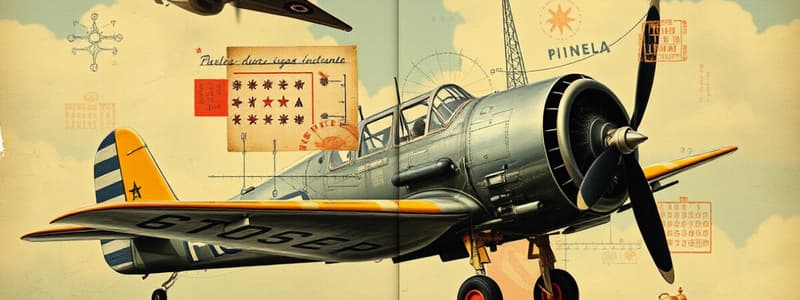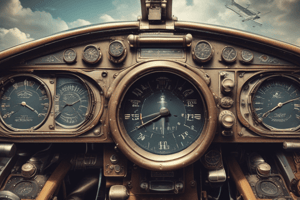Podcast
Questions and Answers
What are the three primary flight instruments that rely on the pitot-static system for air pressure data?
What are the three primary flight instruments that rely on the pitot-static system for air pressure data?
The airspeed indicator, the altimeter, and the vertical speed indicator.
What is the primary function of the Attitude Indicator (AI) in an aircraft's instrument panel?
What is the primary function of the Attitude Indicator (AI) in an aircraft's instrument panel?
Shows the aircraft's pitch and roll relative to the horizon.
Which flight instrument indicates the aircraft's current heading relative to magnetic north?
Which flight instrument indicates the aircraft's current heading relative to magnetic north?
Heading Indicator (HSI).
What are the factors that make the magnetic compass less accurate?
What are the factors that make the magnetic compass less accurate?
In regards to magnetic compasses, what is the error deviation?
In regards to magnetic compasses, what is the error deviation?
In regards to magnetic compasses, what is the error variation?
In regards to magnetic compasses, what is the error variation?
What is the operational difference between the turn coordinator and the turn-and-slip indicator?
What is the operational difference between the turn coordinator and the turn-and-slip indicator?
What type of electrical system does the Piper Archer have, and what components provide electrical power?
What type of electrical system does the Piper Archer have, and what components provide electrical power?
What is the primary function of the vacuum system in an aircraft, and which instruments does it typically power?
What is the primary function of the vacuum system in an aircraft, and which instruments does it typically power?
What are the different formats in which engine instrument information can be displayed on the electronic engine instrument display?
What are the different formats in which engine instrument information can be displayed on the electronic engine instrument display?
What essential flight instruments are typically displayed on the Primary Flight Display (PFD)?
What essential flight instruments are typically displayed on the Primary Flight Display (PFD)?
What type of information does a VHF Omni-Directional Radio Range (VOR) ground station provide to aircraft, and how is it transmitted?
What type of information does a VHF Omni-Directional Radio Range (VOR) ground station provide to aircraft, and how is it transmitted?
What is the main underlying operating principle of an aircraft's Distance Measuring Equipment (DME)?
What is the main underlying operating principle of an aircraft's Distance Measuring Equipment (DME)?
What are the components of the Instrument Landing System (ILS) that provide lateral and vertical guidance to aircraft during approach and landing?
What are the components of the Instrument Landing System (ILS) that provide lateral and vertical guidance to aircraft during approach and landing?
What are the three types of marker beacons typically used in an ILS approach, and what are their respective indications as an aircraft passes over them?
What are the three types of marker beacons typically used in an ILS approach, and what are their respective indications as an aircraft passes over them?
What is the main function of an Automatic Direction Finder (ADF) in aircraft navigation?
What is the main function of an Automatic Direction Finder (ADF) in aircraft navigation?
What is the primary function of an aircraft's transponder, and how does it enhance air traffic control radar detection?
What is the primary function of an aircraft's transponder, and how does it enhance air traffic control radar detection?
What is the purpose of an electronic flight instrument system (EFIS)?
What is the purpose of an electronic flight instrument system (EFIS)?
How many Earth-orbiting satellites make up the Global Positioning System (GPS), and what is the minimum number of satellites visible from anywhere on Earth at any given time for accurate positioning?
How many Earth-orbiting satellites make up the Global Positioning System (GPS), and what is the minimum number of satellites visible from anywhere on Earth at any given time for accurate positioning?
What is the primary function of a Flight Management System (FMS) in an aircraft?
What is the primary function of a Flight Management System (FMS) in an aircraft?
What is the primary function of a Multifunction Display (MFD) in an aircraft?
What is the primary function of a Multifunction Display (MFD) in an aircraft?
What are deicing boots, and where are they typically located on an aircraft?
What are deicing boots, and where are they typically located on an aircraft?
What are deicing boots, and how do they function in the context of propellers or rotor blades?
What are deicing boots, and how do they function in the context of propellers or rotor blades?
What is the purpose of engine anti-ice systems in aircraft, specifically in relation to the air intake?
What is the purpose of engine anti-ice systems in aircraft, specifically in relation to the air intake?
What is the primary function of fuel heaters in an aircraft's fuel system?
What is the primary function of fuel heaters in an aircraft's fuel system?
What is the purpose of pitot heat in an aircraft's pitot-static system?
What is the purpose of pitot heat in an aircraft's pitot-static system?
What is the primary function of weather radar in an aircraft?
What is the primary function of weather radar in an aircraft?
What type of weather advisories are issued to advise en route aircraft of potentially hazardous weather?
What type of weather advisories are issued to advise en route aircraft of potentially hazardous weather?
What are SIGMETs?
What are SIGMETs?
What are AIRMETs?
What are AIRMETs?
What is hypoxia?
What is hypoxia?
What is hyperventilation?
What is hyperventilation?
What are common symptoms experienced by individuals with middle ear or sinus problems during changes in altitude?
What are common symptoms experienced by individuals with middle ear or sinus problems during changes in altitude?
What is spatial disorientation?
What is spatial disorientation?
What causes motion sickness?
What causes motion sickness?
How does alcohol consumption affect a pilot's ability to fly?
How does alcohol consumption affect a pilot's ability to fly?
How does carbon monoxide (CO) primarily affect the body?
How does carbon monoxide (CO) primarily affect the body?
Which gas, when breathed at increased pressure and then ascended too quickly, can lead to decompression sickness (DCS)?
Which gas, when breathed at increased pressure and then ascended too quickly, can lead to decompression sickness (DCS)?
Why is decompression sickness harmful when flying?
Why is decompression sickness harmful when flying?
How can stress affect a pilot's performance?
How can stress affect a pilot's performance?
What is the purpose of 14 CFR Part 61?
What is the purpose of 14 CFR Part 61?
What is the purpose of 14 CFR Part 71?
What is the purpose of 14 CFR Part 71?
What is the purpose of 14 CFR Part 91?
What is the purpose of 14 CFR Part 91?
What is the purpose of 14 CFR Part 95?
What is the purpose of 14 CFR Part 95?
What is the purpose of 14 CFR Part 97?
What is the purpose of 14 CFR Part 97?
What is the primary purpose of the Instrument Flying Handbook?
What is the primary purpose of the Instrument Flying Handbook?
What is the primary purpose of the Aeronautical Information Manual (AIM)?
What is the primary purpose of the Aeronautical Information Manual (AIM)?
What is the primary purpose of the Practical Test Standards (PTS)?
What is the primary purpose of the Practical Test Standards (PTS)?
What is the primary purpose of the Airport Facility Directory (A/FD)?
What is the primary purpose of the Airport Facility Directory (A/FD)?
What is the primary purpose of Standard Instrument Departures (SIDs)?
What is the primary purpose of Standard Instrument Departures (SIDs)?
What do Standard Terminal Arrivals (STARs) primarily assist aircraft with?
What do Standard Terminal Arrivals (STARs) primarily assist aircraft with?
What is the primary purpose of En Route Charts?
What is the primary purpose of En Route Charts?
What is the primary purpose of Standard Instrument Approach Procedure (SIAP) charts?
What is the primary purpose of Standard Instrument Approach Procedure (SIAP) charts?
What are the different types of cloud coverages in aviation?
What are the different types of cloud coverages in aviation?
Flashcards are hidden until you start studying
Study Notes
Flight Instruments and Systems
- The pitot-static system provides data for airspeed indicator, altimeter, and vertical speed indicator.
- The Attitude Indicator (AI) displays aircraft's pitch and roll relative to the horizon.
- Heading Indicator indicates the aircraft's current heading relative to magnetic north.
Magnetic Compass Characteristics
- Magnetic compass accuracy is influenced by deviation and variation.
- Deviation error is caused by the aircraft's magnetic fields impacting compass readings.
- Variation error represents the angular difference between true north and magnetic north, subject to location changes.
Turn Indicators
- Turn coordinator shows rate and direction of a turn; turn-and-slip indicator shows rate of turn and skidding/slipping tendencies.
Electrical Systems in Aircraft
- Piper Archer operates on a 28-volt DC system powered by a 70-amp alternator and 24-volt battery.
Vacuum System and Gyroscopic Instruments
- Vacuum systems power gyroscopic instruments like the attitude and heading indicators by spinning gyroscopes with drawn air.
Engine Instrument Displays
- Engine instrument information can be displayed in analog, digital, graphic, or combined formats.
Primary Flight Display (PFD)
- PFD offers intuitive display of essential flight data like airspeed, altitude, attitude, and heading.
Navigation Systems
- VHF Omni-Directional Radio Range (VOR) ground stations transmit azimuth information, providing courses relative to the station.
- Distance Measuring Equipment (DME) measures the slant range distance from the aircraft to the DME station.
Instrument Landing System
- Instrument Landing System (ILS) provides lateral and vertical guidance through localizer and glideslope.
Marker Beacons in ILS
- ILS marker beacons include outer, middle, and inner markers, each providing specific visual and aural signals upon crossing.
Automatic Direction Finder (ADF)
- ADF facilitates non-precision navigation, identifying direction to ground-based Non-Directional Beacons (NDB).
Aircraft Transponder
- Transponders enhance radar detection by responding with a unique code, aiding identification and altitude reporting.
Electronic Flight Instrument System (EFIS)
- EFIS presents critical flight data digitally, often replacing traditional analog instruments for better readability.
Global Positioning System (GPS)
- The GPS comprises 31 operational satellites, requiring four visible satellites for accurate positioning with about 7-meter accuracy.
Flight Management System (FMS)
- FMS aids in flight planning, navigation, and management for pilots.
Multifunction Display (MFD)
- MFD consolidates various flight information onto one screen for easier access.
Deicing Systems
- Deicing boots on leading edges inflate to break up ice, and anti-ice systems prevent airflow disruptions at the air intake.
Aircraft Safety Systems
- Fuel heaters prevent freezing of fuel, and pitot heat prevents ice buildup in the pitot-static system.
- Weather radar detects precipitation, helping pilots navigate around storms.
Weather Advisory Types
- SIGMETs provide advisories on severe weather affecting all aircraft.
- AIRMETs notify pilots of potential hazards except convective activity, with three types indicating IFR, turbulence, and icing.
Physiological Factors During Flight
- Hypoxia refers to insufficient oxygen reaching body tissues; hyperventilation is an increased rate of breathing.
- Common issues during altitude changes include ear or sinus pressure and pain.
- Spatial disorientation involves confusion regarding body position; motion sickness arises from conflicting sensory signals.
Alcohol and Carbon Monoxide Effects
- Alcohol impairs judgment and reaction time; carbon monoxide reduces oxygen-carrying capability of red blood cells.
- Breathing nitrogen at high pressure followed by rapid ascent can lead to decompression sickness (DCS).
Pilot Performance Under Stress
- Stress negatively impacts judgment and decision-making abilities during flight.
Federal Aviation Regulations (FAR)
- 14 CFR Part 61: Outlines certification requirements for pilots and instructors.
- 14 CFR Part 71: Establishes controlled airspace areas.
- 14 CFR Part 91: Covers general operating and flight rules for civil aviation.
- 14 CFR Part 95: Addresses IFR routes, specifically high-altitude instrument routes.
- 14 CFR Part 97: Contains standards for instrument approach procedures.
Aviation Guides and Manuals
- The Instrument Flying Handbook provides instrument flight principles and procedures guidance.
- The Aeronautical Information Manual (AIM) serves as a comprehensive guide for flight procedures and regulations.
- Practical Test Standards (PTS) assist evaluators in standardized pilot testing.
- The Airport Facility Directory (A/FD) provides essential data for flight planning and navigation.
Standard Departure and Arrival Procedures
- Standard Instrument Departures (SIDs) guide aircraft transitioning from terminal areas to en route navigation.
- Standard Terminal Arrivals (STARs) ensure safe arrivals at busy airports.
Instrument Approach Procedures
- En Route Charts serve navigation aids for aircraft during transit.
- Standard Instrument Approach Procedure (SIAP) charts outline landing protocols under IFR.
Cloud Coverage Types
- SKC: No clouds; FEW: 1/8 to 2/8 covered; SCT: 3/8 to 4/8 covered; BKN: 5/8 to 7/8 is the ceiling; OVC: 8/8 covered. Each 1/8 coverage is called an Okta.
Studying That Suits You
Use AI to generate personalized quizzes and flashcards to suit your learning preferences.




